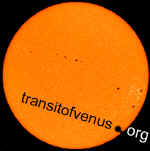 blindlove.jpg
blindlove.jpg
Love is blind! Engraving from Harper's Weekly magazine
(April 28, 1883) shows an observer looking through a telescope apparently with
no solar filter. Such a practice would result in instant eye damage and
likely blindness. Do not let June 8, 2004, be your blind date--use proper
observing equipment and common sense.
Image from Sun-Earth Connection Education Forum, Venus
Transit, Background Reading- Art at http://sunearth.gsfc.nasa.gov/sunearthday/2004/vtbackart.htm.
You can track the transit of Venus live with no risk of eye damage from the sun by watching a narrated webcast from Greece. To observe the transit of Venus directly you must protect your eyes at all times with proper solar filters. However, do not let the requisite warnings scare you away from witnessing this rare spectacle. You can experience the transit of Venus safely, as the guidelines in the red box below suggest.
|
See http://sunearth.gsfc.nasa.gov/eclipse/SEhelp/safety2.html
for definitive advice on solar safety! by B. Ralph Chou, MSc, OD Associate Professor, School of Optometry, University of Waterloo Adapted from NASA RP 1383 Total Solar Eclipse of 1999 August 11, April 1997, p. 19. |
Yes, you can see Venus traversing the sun with no magnification,
provided you use proper eye protection. As suggested in the article above, the use of
#14 shade
welding glass or "eclipse shades" will permit a large number of
people who do not have specialized equipment to observe this event.
However, as the planet approaches the limb of the sun, subtleties like the
black drop effect may not be discernible.
Pinhole projectors are a safe, indirect viewing technique for observing an image of the sun. While popular for viewing solar eclipses, pinhole projectors suffer from the same shortcomings as unmagnified views when Venus approaches the edges of the sun. Small features like the black drop effect and the halo around Venus while it straddles the solar edge may not be discernible.
You may project a magnified view of the sun through a telescope onto a surface, but the technique often has its own limitations. For example, large reflector telescopes can generate too much heat by concentrating a lot of the sun's energy on the secondary mirror and eyepiece. Likewise, SCT or Schmidt-Cassegrain telescopes can experience too much heat build-up as the light bounces internally. Also, magnified projections usually have an exposed focal point beyond the eyepiece where bystanders could inadvertently burn themselves. Constant attention is required. Consult resources, such as the books below, for details on how to view the sun safely by telescope projection. A safer method of projecting a magnified view is through a closed-loop device such as a Sunspotter (below).
The transit of Venus is perhaps best viewed directly when magnified, which demands an appropriate solar filter over the large end of the telescope. Do not use small filters that fit over the eyepiece, for the concentrated sunlight can shatter them. The sun's energy must be attenuated before it enters the telescope. A filtered, magnified view will show the planet Venus, the "black drop" effect, and sunspots. See Solar Filters or http://skyandtelescope.com/observing/objects/sun/article_101_1.asp for a list of retailers.
No matter what proper technique you use for viewing the sun, do not stare continuously at the sun. Give your eyes a break. More safety instructions are at http://www.venus2004.org/sinformer/n/news3366.php?langue=2.
Pinhole Projections
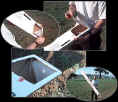
|
Instructions for pinhole projectors are at http://www.exploratorium.edu/eclipse/how.html;
from the Exploratorium.
Other instructions for pinhole projectors and mirror projection techniques are at http://www.shu.ac.uk/eclipse/observe.html and http://www.eclipse.org.uk/safety.htm. Directions for a pinhole camera and related solar activities, such as calculating the diameter of the sun, are available from the Chabot Space & Science Center. |
Eye Wear
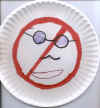
|
NO!
Do not be lulled into thinking that you can look safely at the sun while wearing sunglasses, even at sunrise or sunset. Sunglasses do not protect your eyes sufficiently. So don't try it! Image by Sarah. |
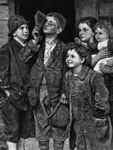 |
NO!
Do not try to view the sun directly with the naked eye or through any questionable medium. These children, depicted on the April 28, 1883, cover of Harper's Weekly, are at risk of serious eye injury. Image from Sun-Earth Connection Education Forum, Venus Transit Background Reading- Art at http://sunearth.gsfc.nasa.gov/sunearthday/2004/vtbackart.htm. |
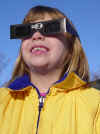 |
Yes.
Eclipse Shades or Solar Shades appear similar to sunglasses, but they have a special filter that permits safe viewing if the filter is in new condition. Eclipse/solar shades are available through Rainbow Symphony and other retailers listed at http://www.mreclipse.com/Totality/TotalityApC.html under "Solar Filters." Before looking at the sun, inspect the material to make sure the lenses are not scratched or compromised in any way. If so, discard the shades. |
|
http://www.astronomyindia.uni.cc/ Sun View goggles are mylar solar filters (not mentioned in above list of retailers). |
#14 Welding Glasses
 |
Dr B. Ralph Chou, author of Eye Safety and Solar Eclipses cited above, suggests "one of the most widely available filters for safe solar viewing is shade number 14 welder's glass." |
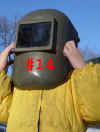 |
It is imperative that the welding hood houses a #14 or darker filter. Do not view through any welding glass if you do not know or cannot discern its shade number. Be advised that welders typically use glass with a shade much less than the necessary #14. Just because the hood makes the sun somewhat more tolerable to see does not mean the welding glass is of the proper kind. |

|
The view through a proper #14 welding glass shows only the sun, which will appear green. The surrounding landscape is not visible. |
 |
A welding glass that is less than shade #14 allows too much light to pass. In the picture at left, an insufficient welding glass permits so much light to pass through that the landscape can be seen. This view is not safe. |
|
TIP |
Here's a tip for viewing the transit of Venus through a hand-held #14 welding glass.
Because the view should be dark, you essentially want your eyes to adapt
to the darkness as if you were seeking night vision. With your body
facing the sun, look down toward your feet and hold the welding glass near
the bridge of your nose. Slowly raise your head to meet the sun,
with your eyes continuously protected by the proper filter.
If you simply look toward the sun and then raise the glass in place, your eyes will need time to adjust to the sudden darkness and will be unnecessarily exposed to the sun, even if only briefly. |
Telescopes with Solar Filters
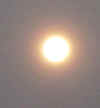
|
Through a telescope with a proper
solar filter, the magnified sun will appear orange or blue. Do
not look through a telescope without a solar filter on the large end
of the scope.
And never use small solar
filters that attach to the eyepiece (as found in some older, cheaper
telescopes). Remove unfiltered finder scopes so they are not inadvertently accessed. Do not rely on a lens cap--even if it is taped on--to keep the eyes of a prying person at bay. (See story below.) |
 |
In practicing for the transit, Flat Stanley recognizes that a proper solar filter must be used to keep his eyes (and the rest of Stanley) from burning. |
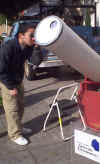 |
Build a solar filter for your telescope with Michael Portuesi at http://www.jotabout.com/portuesi/astro/solar_filter.html. |
Projection Techniques (Magnified View)

|
Bruce Hegerberg's design for a Sun Gun, a device with which a large crowd
can view the magnified sun, is online at http://www.america.net/~boo/html/sun_gun.html |

|
Another viewing tool is Gene Zajacís modified version of a Sun
Gun (see 1999 GLPA
Proceedings). The device safely allows a crowd of spectators
to view a large projection of the sun, the transiting planet, and sunspots.
See also the Must-See TV (Transit Venus) Screen made at the 2003 GLPA
Annual Conference workshop at http://www.transitofvenus.org/tvscreen.htm.
At left, Gene Zajac and Clyde Simpson easily track sunspots. |
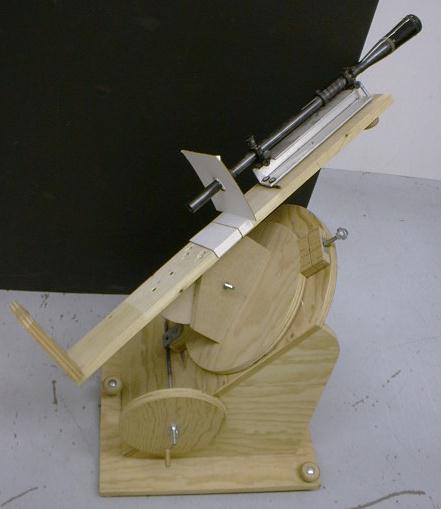 |
Hubert van Hecke provides the design and instructions for making his sunspotter at his Ask Mr. Science web page. Additional pages indicate how to take sunspot data and analyze them. |
 |
The Exploratorium demonstrates how to view a planet in transit safely by projecting the image of the sun with binoculars. See http://www.exploratorium.edu/transit/how.html. Do not look at the sun through binoculars without solar filters on the large ends of the barrels. Never leave this rig unattended. |
 |
You may project an image through a telescope onto a white surface, yet the technique is not foolproof. Among the concerns, because someone can put their eye or body in the sight line of the sun, a projecting telescope must never be left unattended. See http://www.eso.org/outreach/eduoff/vt-2004/vt-safety.html and related links there. For solar activities see http://www.popastro.com/sections/solar/chap3.htm. |
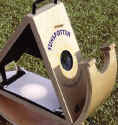 |
The Sunspotter is commercially available from Learning Technologies Inc. |
 |
BinoMite Solar Binoculars are commercially available from Coronado Technology Group. |
| TheVenuscope and solar shades are commercially available from SODAP-SOBOMEX- Department Sky & Space. | |
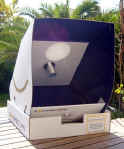 |
A Solarscope is commercially available from Light Tec Optical Instruments. |
 http://SkyandTelescope.com/campaigns.asp?id=344
http://SkyandTelescope.com/campaigns.asp?id=344
Book: How to Observe the Sun Safely by Lee Macdonald; published by Sky &
Telescope.
 http://astronomicalleague.com/sunf.htm
http://astronomicalleague.com/sunf.htm
Book: Observe and Understand the Sun, edited by Richard E. Hill;
published by the Astronomical League.
http://sunearth.gsfc.nasa.gov/sunearthday/2004/vt_observe_2004.htm
"Three separate ways to safely
observe the transit of Venus on June 8, 2004. Those three sections will be
called Views From Students, Views From Observatories and Views From
Satellites."
http://sunspotcycle.com/sunspots/doityourself.html
Safe Sunwatching includes binocular projection techniques from NASA's
spaceweather.com.
http://sunspotcycle.com/sunspots/doityourself_sp.html
Recomendaciones para Observar el Sol
(Spanish version of safe sunwatching, includes binocular projection
techniques from NASA's spaceweather.com).
 http://www.rongross.com/misc/solarview/
http://www.rongross.com/misc/solarview/
Projection device from a simple heliostat; from Ron Gross.
http://skyandtelescope.com/observing/objects/sun/article_101_1.asp
List of telescope filter retailers from Sky & Telescope.
Always beware of the power of the sun. Yes, it obviously can fry your eyes without your knowing it, for your eyeball has no pain receptors within. But there are other burn hazards. Keith Johnson of the Fleischmann Planetarium shares this story:
"Just to underscore the necessity of keeping constant watch on your
telescope while it's pointed at the Sun... I was running a basic
astronomy class lab in Tucson while I was in grad school one day, and
we were observing the Sun with a white-light filter. I had placed a
film container over the finder as usual. But apparently not firmly
enough: it fell off at one point, and I didn't notice it.
One undergrad had come in her pajamas and bathrobe, believe it or not
(it was an early-morning class). While she was peering intently through
the main eyepiece, I noticed some smoke starting to come from the
shoulder of her bathrobe. Sure enough, the finder had set her robe on
fire! or at least smoldering..."
Fine Print: The comments listed on this page are not an endorsement of any particular technique or product. Viewing the sun without proper equipment and/or techniques can result in serious eye injury and blindness. This website accepts no responsibility for the conduct of others in viewing the sun. Observers are responsible for their own eye safety.
"It is never safe to look at the sun without
proper eye protection. No filter should be used with an optical device
(e.g. binoculars, telescope, camera) unless it has been specifically designed
for that purpose and is mounted at the front end (i.e., end towards the Sun). Unsafe
filters include all color film, black-and-white film that contains no
silver, photographic negatives with images on them (x-rays and snapshots),
smoked glass, sunglasses (single or multiple pairs), photographic neutral
density filters and polarizing filters, computer disk media. Most of these
transmit high levels of invisible infrared radiation which can cause a thermal
retinal burn. The fact that the Sun appears dim, or that you feel no
discomfort when looking at the Sun through the filter, is no guarantee that your
eyes are safe. A person with eye damage from improper viewing may not
notice the damage until hours later."
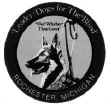 http://www.rollanet.org/~rlions/ldog/
http://www.rollanet.org/~rlions/ldog/
For observers who refuse to view the sun safely--Leader Dogs for the Blind in
Rochester, Michigan.
